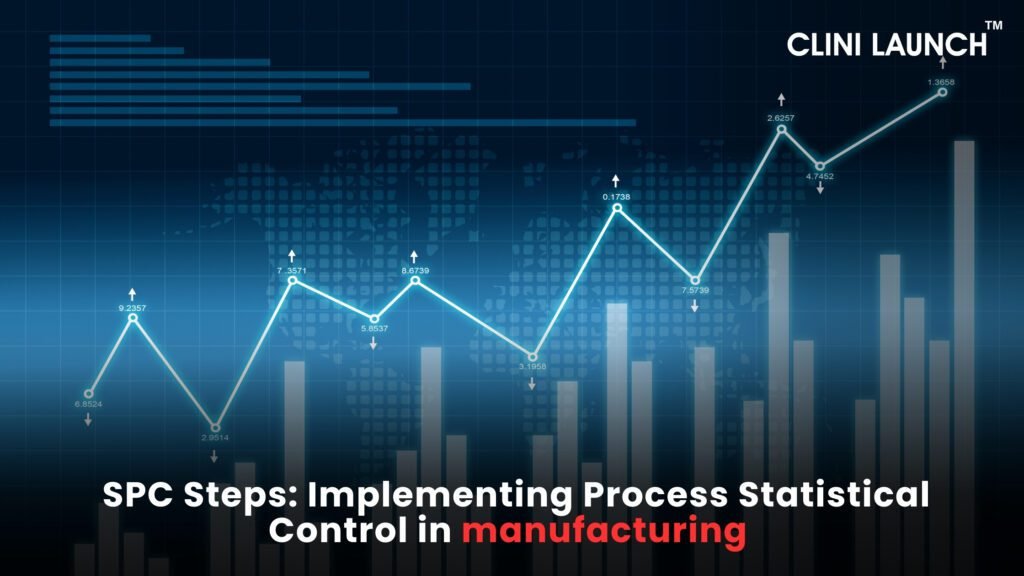What is Process Statistical Control?
Statistical Process Control (SPC) is a proven methodology that employs statistical techniques to monitor and control processes, ensuring efficiency, consistency, and high-quality output. Originally developed by Walter Shewhart at Bell Laboratories in the 1920s, Process Statistical Control was first applied in munitions manufacturing during the 1930s. Today, it is widely used across industries, including bioassays, manufacturing, and development systems, where frequent, repeated processes require optimization.
As the saying goes, “If you cannot measure it, you cannot manage it.” Process Statistical Control provides a structured approach to process improvement by identifying variations and minimizing defects. From implementing key SPC steps to leveraging advanced statistical process control software, businesses can enhance quality and cost-effectiveness. Enhance your understanding with in-depth tools and techniques in our Biostatistics course for deeper insights and better decision-making.
In this blog, we will explore process statistical control (SPC) techniques, their impact on manufacturing and development, and how industries can leverage SPC to achieve process excellence. Scroll down to learn how SPC can transform operations and drive continuous improvement.
To learn more read our blog on 7 Powerful Steps to Master the Methodological Background of Statistical Process Control (SPC).
Process Statistical Control in Manufacturing: Enhancing Quality and Efficiency

Manufacturing is a highly complex industry that involves multiple stakeholders, including suppliers, co-manufacturers, retailers, and customers. Effective communication, process optimization, and quality control are critical for maintaining efficiency and reducing variability. Statistical Process Control (SPC) plays a crucial role in ensuring production consistency through data-driven decision-making. By implementing SPC steps and leveraging advanced process control tools and techniques, manufacturers can minimize defects, improve productivity, and enhance product quality.
Enroll for: Biostatistics Course
Understanding Process Statistical Control in Manufacturing
Applying Process Statistical Control in manufacturing requires a structured approach that involves several fundamental steps:
1. Understanding the Process and Defining Specifications
The first step in statistical process control steps is to gain a comprehensive understanding of the production process, workflow, workstations, and product specification requirements. In larger enterprises, these factors are typically analyzed during the design stage by industrial engineers. However, in small to medium-sized companies, it becomes even more critical to document and measure these processes thoroughly to ensure stability and scalability.
2. Identifying and Controlling Variation
Manufacturers must differentiate between common causes and special causes of variation. By eliminating special causes—such as machine malfunctions, operator errors, or material inconsistencies—only common, manageable variations remain. This allows managers and planners to focus on process improvements and tighten control limits to ensure consistency.
3. Implementing SPC Tools and Monitoring Techniques
To maintain process stability, manufacturers use key SPC techniques such as control charts, histograms, Pareto analysis, and cause-and-effect diagrams. The integration of automation technologies, such as Industrial Internet of Things (IIoT) and Manufacturing Resource Planning (MRP) or Enterprise Resource Planning (ERP) software, further enhances real-time monitoring and control of production processes.
4. Continuous Improvement for Process Stability
The ultimate goal of SPC process statistical control is to achieve a stable process, meaning there is no variation beyond the defined upper and lower control limits. This continuous improvement cycle helps manufacturers reduce rework, minimize waste, and enhance overall efficiency.
The Role of Process Statistical Control Software in Modern Manufacturing
The statistical process control software market has grown significantly, offering advanced solutions tailored for manufacturing. These tools enable real-time data collection, workflow analysis, and process optimization, making them invaluable for Six Sigma project managers, continuous improvement professionals, manufacturing supervisors, and machine operators.
However, selecting the right SPC software requires careful evaluation of factors such as integration capabilities, scalability, and industry-specific requirements. Organizations should seek statistical process control certification to ensure their teams are well-equipped to implement and maintain SPC best practices effectively.
Expanding SPC Beyond Manufacturing: SPC in Healthcare
While SPC is predominantly used in manufacturing, its principles are also highly applicable to healthcare. SPC in healthcare helps monitor and improve patient outcomes, reduce medical errors, and enhance operational efficiency in hospitals, laboratories, and pharmaceutical production. By applying SPC techniques, healthcare professionals can track critical metrics such as patient wait times, medication errors, and surgical success rates, ensuring high-quality standards.
What are the manufacturing challenges and how to overcome the challenges?
Manufacturers operate in a dynamic environment where efficiency and precision are key to success. However, they often face multiple challenges that disrupt operations and impact profitability. From delayed production lines to inefficient production planning, these obstacles can lead to lost sales and increased operational costs.
One major challenge is supply chain inefficiencies, where disruptions and poor collaboration between suppliers, manufacturers, and retailers create bottlenecks. Limited visibility into inventory, demand fluctuations, and logistics issues further complicate production schedules, leading to costly delays.
Additionally, frequent changes in production requirements—whether due to shifting customer demands, regulatory updates, or material shortages—make it difficult to maintain smooth workflows. Without a streamlined process, manufacturers struggle to adapt quickly, affecting overall efficiency.
To stay competitive, manufacturers must adopt process control tools and techniques, including Statistical Process Control (SPC), to optimize operations, enhance collaboration, and ensure seamless production planning. By leveraging data-driven insights and automation, businesses can minimize disruptions, improve efficiency, and drive sustainable growth.
SPC Steps: Implementing Process Statistical Control in manufacturing

1. Understanding the Process and Specifications
The first step in statistical process control steps is comprehensively documenting the production process, workflow, and specification requirements. Large enterprises may measure these elements during the design phase, but small to medium-sized businesses must carefully record and analyze these details to prevent uncontrolled variations.
2. Identifying and Controlling Variation
Manufacturers must distinguish between common and special causes of variation. Eliminating special causes allows companies to develop strategies for controlling the remaining variations, ensuring consistency and predictability in production.
3. Applying SPC Tools for Continuous Monitoring
Using process control tools and techniques such as control charts, Pareto analysis, and histograms, manufacturers can track real-time process performance. The integration of statistical process control software and automation tools like IIoT, MRP, and ERP software further enhances monitoring capabilities.
Enroll for: Biostatistics course
4. Continuous Process Improvement
SPC enables ongoing enhancements by identifying inefficiencies, reducing waste, and ensuring that variations remain within acceptable limits. A continuously improving process results in increased productivity, quality assurance, and cost savings.
Statistical Process Control Tools
Over the years, SPC has developed standard quality control (QC) tools and supplemental tools (SUPP) to analyze and improve manufacturing processes.
The Seven Quality Control (7-QC) Tools
- Cause and Effect Diagram (Fishbone Diagram) – Identifies multiple potential causes of variation and categorizes them for analysis.
- Check Sheet – A simple data collection tool used to track and analyze variations over time.
- Control Chart – Maps process changes and determines whether production is within statistical control limits.
- Histogram – A bar graph that groups data into ranges for easy interpretation.
- Pareto Chart – Highlights the most significant causes of variation using a bar graph sorted from most to least frequent.
- Scatter Diagram – Displays relationships between two variables to determine correlation.
- Stratification – Groups and categorizes raw data for better analysis.
The Seven Supplemental (7-SUPP) Tools
Additional tools were developed to enhance the effectiveness of SPC techniques, including:
- Process mapping
- Decision trees
- Failure mode and effects analysis (FMEA)
- Fault tree analysis
These tools help manufacturers refine processes, improve decision-making, and mitigate risks associated with variations.
Common Variations and controls in Manufacturing
1. Wear and Tear
Manufacturing components such as shafts, belts, and gears degrade over time. SPC allows companies to measure and analyze wear to optimize lifecycle performance and maintain product consistency.
2. Environmental Conditions
Temperature, humidity, and pressure changes affect production processes. SPC techniques help manufacturers adjust process parameters to maintain consistent product quality despite environmental fluctuations.
3. Seasonal Workforce Variability
Companies that hire seasonal staff may experience variations in quality due to training differences. SPC helps measure and adjust production expectations based on workforce changes.
4. Lot-to-Lot Differentiation
Raw materials, such as cotton or minerals, vary across batches. SPC enables manufacturers to analyze these differences and adjust processes accordingly to maintain uniformity.
Statistical Process Control Software Market
The statistical process control software market has expanded significantly, offering tools designed for:
- Six Sigma project managers
- Manufacturing supervisors
- Continuous improvement professionals
- Machine operators
SPC software solutions streamline data collection, automate analysis, and improve compliance with industry standards. Choosing the right software requires evaluating factors like integration capabilities, scalability, and specific industry needs.
Read our blog on What is Survival Analysis in Biostatistics: Time-to-Event Data 2025
SPC in Healthcare: Expanding Beyond Manufacturing
While SPC is primarily used in manufacturing, it has gained traction in healthcare to improve patient care, reduce errors, and optimize operations. SPC in healthcare is applied to:
- Monitor patient wait times
- Analyze surgical success rates
- Reduce medication errors
By implementing SPC techniques, healthcare providers can ensure high-quality patient outcomes and enhance efficiency.
Benefits of Using Process Statistical Control Techniques

When properly applied, SPC techniques offer several advantages:
- Reduced Waste – Minimizes defects and rework, reducing material waste.
- Higher Productivity – Streamlined processes lead to improved efficiency and cost savings.
- Continuous Improvement – Real-time monitoring allows for proactive problem resolution.
- Better Decision-Making – Data-driven insights support more effective management decisions.
- Enhanced Process Capability – Helps manufacturers determine when to expand or upgrade production capacity.
Conclusion
Statistical Process Control (SPC) is a powerful methodology that ensures process stability, improves quality, and enhances operational efficiency. By following SPC steps, leveraging process control tools and techniques, and integrating statistical process control software, manufacturers can optimize production, reduce waste, and maintain compliance with industry standards.
Beyond manufacturing, SPC in healthcare demonstrates its versatility in improving patient outcomes and healthcare operations. Investing in SPC techniques, statistical process control certification, and the right SPC software will position businesses for long-term success and competitive advantage in an increasingly quality-driven market. For those looking to deepen their statistical knowledge in clinical research, enrol for Biostatistics course at Clini Launch.
Frequently Asked Questions:
- What is Statistical Process Control (SPC)?
Statistical Process Control (SPC) is a data-driven quality control method that applies statistical techniques to monitor, control, and improve a process. By implementing SPC steps and leveraging process control tools and techniques, organizations can reduce process variation, minimize defects, and enhance product quality. SPC plays a crucial role in industries such as manufacturing, pharmaceuticals, and SPC in healthcare, ensuring compliance with regulatory standards.
2. What is process capability?
Process capability is a statistical measure that evaluates whether a process can consistently produce output within specified limits. It compares the specification width to the process variation and is a key indicator of process efficiency. Organizations seeking statistical process control certification use process capability analysis to ensure quality consistency and compliance with industry standards.
3. What are control charts in SPC?
Control charts are fundamental SPC techniques used to track process variations over time. These charts consist of a central line (mean), an upper control limit, and a lower control limit, all derived from historical data. By analyzing control charts, businesses can distinguish between common and special cause variations, allowing for proactive adjustments to maintain process statistical control.
References:
- https://www.sciencedirect.com/science/article/pii/S2212827116001529
- https://blog.3dcs.com/a-manufacturers-guide-to-understanding-spc-software-and-vendors






An outstanding share! I’ve just forwarded this onto a friend who had been conducting a
little research on this. And he in fact bought me dinner because I stumbled upon it for him…
lol. So let me reword this…. Thank YOU for the meal!!
But yeah, thanks for spending some time to talk
about this topic here on your blog.
Thank you! Glad you liked the blog